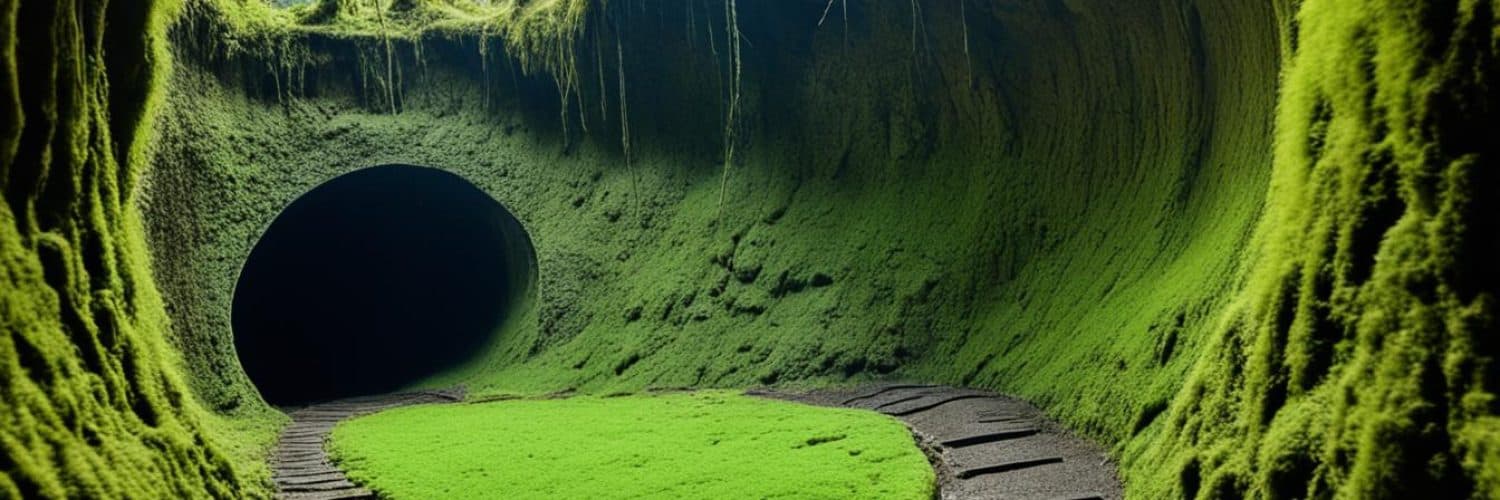Are you ready to uncover a hidden gem that takes you back in time to the events of World War II? Prepare to be captivated as you embark on a journey through the historic Japanese Tunnel in Davao City, Mindanao. This tourist attraction is not only a must-visit landmark but also a cultural heritage site that holds immense significance. Get ready to explore the secrets of the tunnel and immerse yourself in the rich history of the region.
Key Takeaways:
- Japanese Tunnel in Davao City, Mindanao is a historic site from World War II.
- It is a hidden gem and a cultural heritage site.
- Explore the tunnel and learn about the events that shaped the region.
- Immerse yourself in the eerie atmosphere of the tunnel.
- Don’t miss the opportunity to visit this must-see landmark in Davao City.
The History of Japanese Tunnel
The Japanese Tunnel in Davao City, Mindanao, holds a rich history from World War II. This 300-meter long tunnel was discovered during the construction of a hotel. Its passageways, rooms, and armaments revealed the struggles and events that took place during the war.
Dug by war prisoners under the order of the Japanese Imperial Army, the Japanese Tunnel served as a hiding place for Japanese soldiers and as a headquarters. Inside, small chambers were used as offices and dungeons for prisoners. The tunnel is also home to artifacts such as vintage guns, explosives, and ammunition, reflecting the role it played during the war.
The American liberating army pursued the Japanese soldiers, and the tunnel stands as a testament to the wartime conflicts and the bravery of those involved.
The Japanese Tunnel in Davao City, Mindanao, reveals the struggles and events of World War II. From its construction by war prisoners to its use as a hiding place and headquarters by Japanese soldiers, the tunnel holds historical significance. It is a reminder of the brave individuals who fought during the war and offers insights into the events that took place in Davao City.
Location and How to Get There
If you’re planning a visit to the Japanese Tunnel in Davao City, Mindanao, you’ll find it located along the South Diversion Road, in Hillcrest Subdivision, Matina Balusong. This historic site is just a 30-minute drive from downtown Davao, making it easily accessible for tourists and locals alike.
To reach the Japanese Tunnel, there are several options available. Visitors can hire a cab or take a taxi from downtown Davao, ensuring a convenient and hassle-free journey. Additionally, many tour providers in the city include the Japanese Tunnel in their itineraries, offering guided trips to this fascinating cultural landmark.
Once you arrive, you’ll be able to immerse yourself in the historical significance of the Japanese Tunnel and explore the remnants of World War II firsthand.
Exploring the Japanese Tunnel
Embark on a fascinating journey as you explore the depths of the Japanese Tunnel in Davao City, Mindanao. For a nominal entrance fee, visitors can enjoy a guided tour that gives a captivating insight into the history of this remarkable site. Immerse yourself in the ambiance as you step through the entrance, guarded by life-sized statues of brave Japanese soldiers. Inside the tunnel, a treasure trove of artifacts awaits, providing a glimpse into the experiences of the soldiers during the war.
The Japanese Tunnel is adorned with an impressive collection of vintage weaponry, including bullets, rifles, and machine guns. Marvel at the craftsmanship and power of these historical artifacts as you learn about their significance in the context of World War II. As you explore further, you’ll come across serene chapels within the tunnel, offering a moment of reflection. One of these chapels houses replicas of gold bars and the iconic Golden Buddha, adding a touch of spiritual reverence to the experience.
With its rich historical significance and tangible artifacts, the Japanese Tunnel is a testament to the resilience of the past. It provides an immersive experience that allows you to step back in time and gain a deeper understanding of the events that unfolded during the war. Whether you are a history enthusiast or simply seeking a unique exploration, the Japanese Tunnel in Davao City is not to be missed.
Experience the captivating atmosphere of the Japanese Tunnel with a guided tour and discover the stories and relics that bring history to life. Immerse yourself in the ambiance of the tunnels, surrounded by the remnants of the past, and gain a newfound appreciation for the bravery and sacrifices of those who came before us.
The Hotel and Restaurant
The Japanese Tunnel site also features a three-story hotel and restaurant. Guests can enjoy well-appointed accommodations, wireless internet access, and an outdoor pool at affordable rates. The hotel offers comfortable rooms and amenities to ensure a pleasant stay for visitors.
The restaurant at the Japanese Tunnel provides a delightful dining experience with a diverse menu. Guests can choose from a range of cuisines, including Japanese, Western, Filipino, and Chinese dishes. Whether you’re craving traditional Japanese sushi, hearty Western favorites, flavorful Filipino delicacies, or authentic Chinese cuisine, the restaurant has something to satisfy every palate.
Furthermore, there is a cozy coffee shop on-site where visitors can relax and enjoy a cup of freshly brewed coffee. Whether you need a caffeine boost in the morning or a relaxing break in the afternoon, the coffee shop offers a tranquil atmosphere and a variety of coffee options to choose from.
The Significance of the Japanese Tunnel
The Japanese Tunnel in Davao City, Mindanao, holds immense historical significance as a remnant of the Japanese occupation during World War II. This underground complex serves as a poignant reminder of the events that shaped the history of the region and the country as a whole. Its preservation and exploration contribute to a deeper understanding of the cultural heritage and the impact of the war on the local community.
The Japanese Tunnel stands as a silent witness to the Japanese occupation, offering a glimpse into the challenging times faced by both occupiers and locals during the war. It provides valuable insights into the strategies and tactics employed by the Japanese soldiers and the hardships endured by prisoners of war.
The Japanese Tunnel is a powerful testament to the resilience and strength of the Filipino people in the face of adversity. It serves as a symbol of their unwavering spirit and the sacrifices made to defend their homeland.
Exploring the Japanese Tunnel allows visitors to immerse themselves in the history of the region and gain a deeper appreciation for the cultural heritage it represents. By preserving and showcasing this important historical site, Davao City not only honors the past but also educates future generations about the realities of war and the significance of peace and harmony.
Other Historical Tunnels in Davao
Aside from the Japanese Tunnel, there are several other historical tunnels that can be discovered in the hilly portions of southern Davao. However, due to rapid developments in the city, many of these tunnels have either been filled in or forgotten, leaving the Japanese Tunnel as a remarkable testament to the past.
These forgotten tunnels, once used for various purposes, hold great historical significance and offer a glimpse into the rich heritage of the region. Exploring these hidden tunnels allows visitors to step back in time and better understand the events that shaped Davao’s history.
To give you an idea of the scale and diversity of these tunnels, here is a list of some other notable ones that have been discovered:
| Tunnel Name | Location | Description |
|---|---|---|
| Digos Tunnel | Digos City | A tunnel used by the guerrillas during the Japanese occupation. |
| Malagos Tunnel | Malagos | A tunnel believed to have been used as a hideout and supply route during the war. |
| Sirawan Tunnel | Toril | A tunnel used as a communication network during World War II. |
These forgotten tunnels are a valuable part of Davao’s history and deserve attention and preservation. Exploring them not only provides a unique and adventurous experience but also contributes to the understanding and appreciation of the region’s heritage. So, if you’re interested in delving deeper into the fascinating history of Davao, be sure to uncover these hidden treasures.
Discovering the Malagos Tunnel
One of the most intriguing tunnels in Davao is the Malagos Tunnel, located in the barangay of Malagos. This tunnel is believed to have served as a hideout and supply route for the resistance fighters during the Japanese occupation. Exploring the Malagos Tunnel takes you on a journey through the wartime era, offering a glimpse into the struggles and bravery of the guerrilla forces. The tunnel’s dark and eerie atmosphere adds to its mystique, making it a must-visit site for history enthusiasts and adventure seekers alike.
Importance of Historical Places
Historical places hold immense value in preserving a nation’s rich heritage and understanding its history. In the Philippines, these sites play a crucial role in shaping the country’s identity and connecting its people to their roots. The Japanese Tunnel in Davao City, Mindanao, is an example of such a historical place that offers profound insights into the events that unfolded during World War II.
Exploring these historical sites allows us to delve into the past and grasp the true essence of significant moments. By immersing ourselves in the stories and experiences associated with these places, we gain a deeper understanding of our nation’s journey and the forces that have shaped it. Whether it’s investigating the tunnels where soldiers sought shelter or admiring ancient structures, historical places provide a tangible link to a nation’s story.
“Historical places are more than just physical remnants of the past; they serve as windows to our heritage and give context to our present.”
Preserving these sites also ensures that future generations can appreciate and learn from them. By safeguarding historical places like the Japanese Tunnel, we guarantee that the knowledge and lessons embedded within these locations are passed down. These sites become educational resources, inspiring curiosity and offering invaluable lessons to both locals and visitors alike.
Historical places bear witness to the triumphs, struggles, and cultural transformations of a nation. They provide a tangible and immersive experience that textbooks and documentaries can never fully capture. By exploring these sites, we gain a more profound understanding of our collective history and develop a greater sense of appreciation for the cultural heritage that has shaped our country.
Preserving the Past for the Future
In the fast-paced world we live in, it is crucial to recognize and preserve historical places. These landmarks provide a link to our collective past and offer a glimpse into the events and stories that have molded our nation. By protecting and celebrating historical places, we ensure that future generations can continue to learn from and appreciate these treasures.
Let us embrace and safeguard the historical places like the Japanese Tunnel in Davao City, Mindanao, and cherish them as tangible reminders of our shared heritage.
Experience the Eerie Atmosphere
The Japanese Tunnel in Davao City, Mindanao, offers a truly unique experience that is sure to send shivers down your spine. As you walk through the passageways that were once occupied by war prisoners, an eerie feeling envelops you, transporting you back to a haunting chapter of history.
Inside the tunnel, the atmosphere is charged with a ghostly presence that evokes the suffering endured by those who were held captive during World War II. The echoes of the past linger, creating an unsettling ambiance that adds depth and emotion to your visit.
Immerse yourself in the history and contemplate the experiences of the war prisoners as you navigate this underground labyrinth. The Japanese Tunnel’s eerie atmosphere provides a poignant reminder of the hardships endured and the sacrifices made during those turbulent times.
Whether you are a history enthusiast or simply seeking a unique and thought-provoking experience, the Japanese Tunnel in Davao City is a must-visit destination. Prepare to be captivated by the unsettling aura that lingers within its walls.
Visitor Testimonials:
“Walking through the Japanese Tunnel was an experience like no other. The eerie atmosphere stayed with me long after the visit, leaving me with a newfound appreciation for the resilience of those who endured such hardships during the war.” – Maria, Philippines
“The ghostly presence inside the Japanese Tunnel sent chills down my spine. It was a haunting yet captivating experience that I won’t forget. A must-see for anyone visiting Davao City.” – Mark, USA
Plan Your Visit
To experience the eerie atmosphere of the Japanese Tunnel in Davao City, Mindanao, be sure to plan your visit ahead of time. Check the operating hours and ticket prices to ensure a smooth and seamless experience. We recommend joining a guided tour to gain deeper insights into the historical significance of the site.
Remember to embrace the somber ambiance, pay homage to the war prisoners, and reflect on the turbulent history that unfolded within these dark tunnels. The Japanese Tunnel is more than a tourist attraction; it is a gateway to the past, preserving the memory of those who endured the unimaginable.
The Role of the Japanese Tunnel in Tourism
The Japanese Tunnel in Davao City, Mindanao, plays a significant role in the local tourism industry. Its historical importance and unique visitor experience make it a popular attraction for both domestic and international tourists.
Located in Davao City, Mindanao, the Japanese Tunnel is a hidden gem that adds to the cultural heritage of the region. As visitors explore the tunnel, they are immersed in the history of the Japanese occupation during World War II, gaining insights into the events and struggles of the past.
The tunnel offers a memorable visitor experience, creating a sense of intrigue and curiosity. Walking through the passageways and chambers, visitors can witness artifacts and relics from the war, such as vintage weaponry and other reminders of the past.
By showcasing the cultural heritage of the region, the Japanese Tunnel contributes to the overall tourism industry of Davao City. It attracts travelers who are interested in historical sites and provides them with a unique perspective on the events that shaped the area.
Visiting the Japanese Tunnel in Davao City, Mindanao, is not only a journey back in time but also an opportunity to appreciate the significance of this hidden gem. It offers a glimpse into the past and allows visitors to connect with the history and cultural heritage of the region in a profound way.
| Benefits of the Japanese Tunnel for Tourism |
|---|
| 1. Unique historical attraction |
| 2. Cultural heritage experience |
| 3. Memorable visitor experience |
| 4. Contribution to the tourism industry of Davao City |
Overall, the Japanese Tunnel in Davao City, Mindanao, is an essential component of the local tourism landscape. Its historical significance, hidden gem status, and cultural heritage make it a must-visit attraction for those seeking a unique and enriching visitor experience.
The Future of the Japanese Tunnel
The Japanese Tunnel in Davao City, Mindanao, holds immense historical significance and is a key tourist attraction. As the city focuses on tourism development and preserving its cultural heritage, the Japanese Tunnel will continue to play a crucial role in achieving these objectives.
Efforts will be made to ensure the preservation and maintenance of the Japanese Tunnel, guaranteeing that future generations have the opportunity to explore and appreciate its historical significance. With ongoing upkeep, the tunnel will remain an important landmark in Davao City’s rich past, allowing visitors to connect with the events that shaped the region. This commitment to preservation will also contribute to the overall tourism industry and attract more visitors to the city.
By maintaining the Japanese Tunnel, Davao City demonstrates its dedication to preserving history and promoting tourism development. The tunnel stands as a testament to the bravery and sacrifices of those who lived through World War II, and its continued preservation will ensure that their stories are never forgotten.
| Benefits of Preservation | Efforts for Maintenance |
|---|---|
| 1. Preserving historical significance for future generations | 1. Regular inspections and repairs |
| 2. Attracting tourists interested in history and cultural heritage | 2. Implementing conservation measures to prevent deterioration |
| 3. Boosting tourism industry and local economy | 3. Collaboration with experts in historical preservation |
| 4. Enhancing the city’s reputation as a tourist destination | 4. Engaging local community in restoration efforts |
Preservation of the Japanese Tunnel not only safeguards its historical importance but also opens doors for educational opportunities and research. Scholars and historians can delve deeper into the events that unfolded within its walls, providing valuable insights and expanding our understanding of the past.
The Japanese Tunnel is an integral part of Davao City’s heritage, and its future lies in the hands of those dedicated to its preservation. By prioritizing maintenance and ensuring its accessibility, the city remains committed to sharing this significant piece of history with the world.
Conclusion
The Japanese Tunnel in Davao City, Mindanao, is a historic site and a must-visit tourist attraction that holds significant importance from World War II. As a hidden gem, it showcases the cultural heritage of the region and provides visitors with a unique insight into the events of the past.
Exploring the Japanese Tunnel is a truly memorable experience. Walking through the passageways and rooms that once harbored Japanese soldiers and war prisoners during the war evokes a sense of history and appreciation. The eerie atmosphere inside the tunnel adds to its allure, giving visitors a glimpse into the struggles and sacrifices of the past.
The Japanese Tunnel is not only a significant landmark but also a testament to the enduring spirit of the people. Its preservation and exploration contribute to the understanding of the cultural heritage of Davao City and the impact of World War II on the local community. For travelers seeking a unique historical experience, the Japanese Tunnel is a must-visit site in Mindanao.


















Add comment